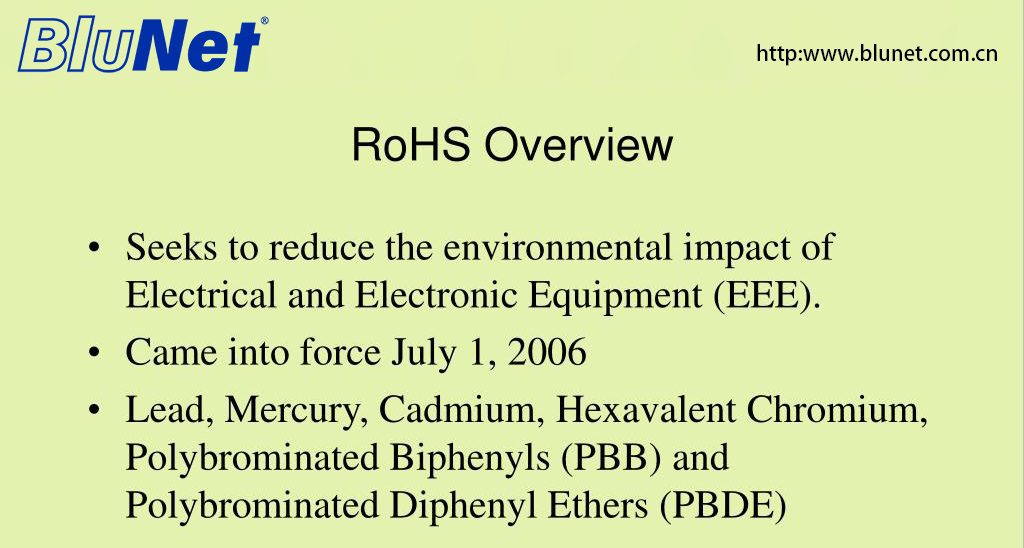RoHS Restriction |The Restriction of Hazardous Substances
RoHS, short for Restriction of Hazardous Substances, is an acronym you should know. It refers to Directive 2002/95/EC, a European regulatory framework that restricts the use of hazardous substances in electrical and electronic products. Since July 1, 2006, it has become mandatory for all products sold within the European Union to comply with RoHS regulations. This directive ensures that the use of specific hazardous substances is minimized, promoting safer and more environmentally friendly products in the EU market.

RoHS specifically targets six harmful substances: lead (Pb), mercury (Hg), cadmium (Cd), hexavalent chromium (CrVI), polybrominated biphenyls (PBBs), and polybrominated diphenyl ethers (PBDEs). These substances are restricted in electrical and electronic products due to their potential adverse effects on human health, including carcinogenic, mutagenic, and toxic properties and their negative impact on ecosystems.
ROHS RESTRICTION
| RoHS-Six Restriction of Hazardous Substances | |
| The Restriction of Hazardous Substances | |
| 1. Cadmium (Cd) | < 100 ppm |
| 2. Lead (Pb) | < 1000 ppm |
| 3. Mercury (Hg) | < 1000 ppm |
| 4. Hexavalent
Chromium (Cr 6+) |
< 1000 ppm |
| 5. Polybrominated
Diphenyl Ethers (PBDE) |
< 1000 ppm |
| 6. Polybrominated
Biphenyls (PBB) |
< 1000 ppm |
| PPM: ppm = parts per million, a unit of measurement for weight percentage. 1 ppm = 1 mg/kg =0.0001 % by weight. | |
| How The Hazardous Substances Affect Human | |
| 1. Cadmium (Cd) | Cadmium exposure is linked to renal dysfunction, growth disturbances, skeletal damage, reproductive deficiencies, and suspected associations with liver, lung, and prostate cancer. |
| 2. Lead (Pb) | Lead has toxic effects on the endocrine and nervous systems, causing brain damage in children. It also harms the blood system and kidneys and negatively impacts children’s brain development. |
| 3. Mercury (Hg) | It can induce chronic organ damage, specifically affecting the brain, kidneys, and fetus. |
| 4. Hexavalent
Chromium (Cr 6+) |
Even in low concentrations, Chromium VI triggers potent allergic reactions, including asthmatic bronchitis. Furthermore, it has the potential to damage DNA. |
| 5. Polybrominated
Diphenyl Ethers (PBDE)
|
It disrupts liver enzyme production, adversely impacts the thyroid hormone system, and triggers immunotoxicity. During a critical period of brain growth, its administration induces neurotoxicity. |
| 6. Polybrominated
Biphenyls (PBB) |
|
The RoHS Directive applies to various electrical and electronic equipment, including household appliances, IT and telecommunications equipment, lighting products, medical devices, and more. It requires manufacturers, importers, and distributors to ensure their products comply with the maximum allowable concentrations of the restricted substances.
To comply with RoHS, manufacturers must conduct thorough testing and implement strict control measures throughout their supply chains to ensure the absence or minimal presence of the restricted substances. Compliance is typically achieved through material declarations, testing of components, and implementing robust quality control systems.
National authorities within each EU member state enforce RoHS. They conduct market surveillance activities and random product inspections to ensure compliance. Non-compliant products can be prohibited from the market, and penalties may be imposed on violators.
RoHS compliance is not limited to products sold in the EU. Many countries and regions worldwide have implemented similar regulations or adopted RoHS-like requirements for restricting hazardous substances in electronic products. This global trend reflects the growing awareness and commitment to environmental sustainability and the safe handling of electronic waste.
By restricting the use of hazardous substances in electrical and electronic products, RoHS aims to promote the development and use of safer, more environmentally friendly technologies and contribute to the overall well-being of individuals and the planet.











No comment